| |
| Columbanus |
|
Columbanus
is born in the southeast of the country, on the border
of Carlow and Wexford in 543. Prior to his birth, his
mother dreams of a brilliant sun, which arises from
her breast and illuminates the whole world. As a premonition,
it doesn't fall too wide of the mark.
|
As
a youth, Columbanus' good looks win him unwanted attention
from the opposite gender. He takes the advice of a holy woman,
who tells him to steer clear of such entanglements. Columbanus
sets his sights on a life of self-sacrifice.
|
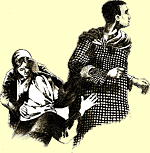 |
Columbanus'
mother is distraught at the thought of his leaving,
and pleads with her son to stay. All to no avail, however,
as Columbanus steps across her prostrate body, and tells
her not to grieve.
| He
studies under Sinell in Cleenish, and while there,
forms his decision to become a monk. Columbanus
leaves for Bangor, the monastery with the most ascetic
ethos in the country. |
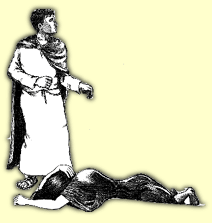 |
|
| |
read
more |
| The
austerity of Abbot Comgall's regime suits Columbanus'
temperament. He thrives there, one of the few to be raised
to the priesthood from among the brethren. He becomes
an important figure in Bangor, a valued member of staff.
As a result, when Columbanus first approaches |
| |
|
Comgall
with a view to going abroad, he isn't met with enthusiasm.
In the end however, persistence pays off, and Comgall
agrees to the departure of his star protégé.
Columbanus sails out from Bangor in 590 with twelve of
his brethren, travelling via Cornwall to St Malo in France.
They take the Roman road east to Rheims, the capital of
the kingdom of the Franks. |
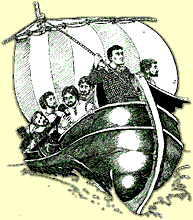 |
| |
|
|
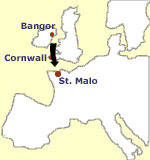
St.
Columbanus in France
|
At
this time in history, this part of Europe has experienced
war between rival kingdoms. Coupled with the negligence
of local bishops, this has led to a breakdown in
the practice of religion. Be that as it may, Columbanus
and his brethren are well received by King Gunthran
of Burgundy and Austrasia, who begs the Irish party
to remain in his kingdom. |
|
| |
| Columbanus
agrees to stay, but insists on a remote location. He finds
a suitable site in the mountainous region of the Vosges,
in an old Roman settlement called Annegray. There, the
monks attempt to survive on a diet of herbs, roots and
the bark of trees. Fortunately, help is at hand in the
form of Saulcy monastery, a day's journey away. Abbot
Carantoc instructs his cellarer, Marculf, to bring supplies
to the new arrivals in the region. |
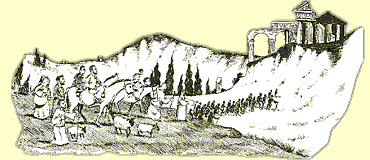 |
|
Marculf
brings back stories about the new community and their
ascetic lifestyle. As a result, people start to flock
in pilgrimage to those who have left the world behind
in Annegray. Columbanus regularly retreats from his
community and pilgrims to a cave four hundred feet above
the monastery in the valley of the Breuchin.
Annegray
attracts vocations in such number that it is necessary
to open a second monastery. Columbanus travels eight
miles west to Luxeuil, and with the permission of the
young King Childebert II, begins his second foundation.
It is destined for fame and success, and to outgrow
Annegray. Indeed, it grows at such a rate, that a third
monastery is opened at Fontaine, three miles north of
Luxeuil. Luxeuil is the motherhouse of the three monasteries.
|
| |
|
|
The
Rule, which Columbanus devises for his three monasteries,
is based on the asceticism he learned at Bangor. Obedience
is the cornerstone of the system, and there is great
emphasis laid on the confession of faults.
In
spite of the success of the monasteries, Columbanus
is not a favourite with the local Church hierarchy.
His strict adherence to monastic discipline makes those
who have committed simony and adultery feel uncomfortable.
As well as that, his unauthorised foundations and independence
of action ignore the bishops' prerogative.
Following
the death of King Childebert II in 595, the political
situation changes. Theuderich, the new king of Burgundy,
has four children by his concubines. When his mother,
Brunhilde, parades them before Columbanus on one of
his visits to the royal household, the Irishman refuses
to bless them, saying: "These will never hold the
royal sceptre because they were begotten in sin."
It is the beginning of a downturn in relations.
|
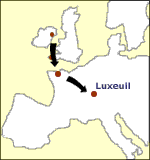
St.
Columbanus in France |
Theuderich
demands access to all areas of Luxeuil monastery, something
Columbanus refuses outright. Theuderich decrees that
monks who cut themselves off from the world must leave
Burgundy and return to their country of origin. Thus
Columbanus must make his way across France to Nantes,
a journey of six hundred miles.
|
| |
| In
spite of his age - he is nearing 70 - Columbanus completes
the journey, and is all set to leave France. However,
fate intervenes in the shape of a storm, which blows up
at the mouth of the Loire, driving Columbanus' ship aground.
The captain of the vessel interprets the storm as a sign
from God that the monks were meant to remain here. |
| With
the relationship with King Theuderich irreparable, Columbanus
heads north to Soissons, to the court of King Clothair
II of Neustrasia. Following a hospitable reception, he
journeys on to Metz, to the court of King Theudebert of
Austrasia. Also there to meet Columbanus are members of
the Luxeuil community, who had learned of his journey.
Theudebert invites the monks to settle in his kingdom
and preach to the pagan tribes on the eastern border. |
 |
|
|
Travelling
over water, through the Moselle and the Rhine and its
tributaries, Columbanus and his brethren come to Bregenz
on the southern shore of Lake Constance. Their monastery
here lasts from the latter part of 610 to the beginning
of 612. Once again, politics plays a key part in Columbanus'
fate.
|
|
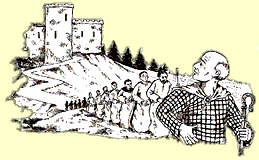
St.
Columbanus in Austria |
|
In
the spring of 612, war breaks out between Austrasia and Burgundy,
with Columbanus' supporter, King Theudebert, being comprehensively
beaten by King Theuderich. With Austrasia now added to the
kingdom of Burgundy, Columbanus finds himself in a vulnerable
position. Over the past eighteen months, he and his monks
have undertaken an uncompromising brand of mission, smashing
pagan idols and disrupting pagan ceremonies. Now, with monks
being murdered in the woods, the writing is on the wall for
Columbanus. It's time to move
|
Columbanus
decides to head for Italy, a suggestion that fails to
meet with the favour of his mostly Germanic brethren.
Even Gall is reluctant to follow his fellow expatriate
into this next remove. Forbidding Gall to say Mass while
he himself is still alive, Columanus travels towards
the Alps with a reduced party of monks.
|
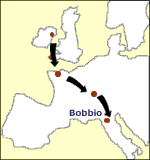
St.
Columbanus in Italy |
| Thus
he comes to the court of King Agiluf and Queen Theudelina
in Lombardy, an area of Italy settled by German tribes
in Columbanus' own lifetime. |
| He
spends much of 613 in Milan, displaying all his customary
drive
as he throws himself into the Arian controversy surrounding
the divinity of Christ. The Christians of Lombardy, including
the king and queen, are all Arians, and not loyal to the
doctrine of Rome. |
| |
|
Fortunately,
this doctrinal difference doesn't sour relations between
monk and king, and Columbanus is offered a site seventy
miles south, where the Bobbio stream flows into the
Trebbia on its way to the Po. Columbanus gladly accepts,
and before the winter of 614 sets in, a new Irish monastery
called Bobbio takes shape in the foothills of the Apennines.
It
is to be the last of Columbanus' foundations and his
final resting place. In his last days on earth, his
thoughts turn to Gall, the last of the gang from Bangor.
Nearing death, Columbanus orders that his staff be sent
to Gall as a token of forgiveness. In the early hours
of Sunday 23 November, 615, Columbanus breathes his
last. Gall duly receives the staff, treasuring it till
his own death in 630 on the shore of Lake Constance.
|
|
|
|
Related
Links  |
|
|
|
